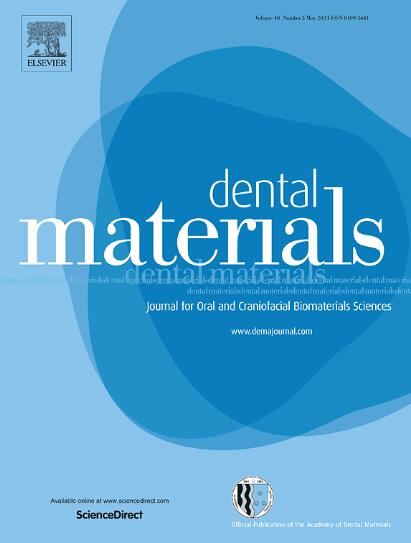评估可流动与可雕刻牙科树脂基复合材料时空聚合变化的新兴技术。
IF 6.3
1区 医学
Q1 DENTISTRY, ORAL SURGERY & MEDICINE
引用次数: 0
摘要
背景:本研究提出了一种新颖的多技术方法,该方法将显微计算机断层扫描(micro-CT)和光学光热红外光谱(O-PTIR)结合在一起,用于评估可流动和可雕刻牙科树脂基复合材料之间的聚合差异,即所谓的时空聚合特性:方法:研究了十种市售牙科复合材料,包括同一制造商生产的可流动和可雕刻复合材料。对八个参数进行了评估:使用实时监控的 ATR-FTIR 测量短期聚合特性(5 分钟后的转化程度、最大聚合率、达到最大聚合率的时间);使用 O-PTIR 评估转化程度随深度的变化;使用 micro-CT 测量收缩模式的三维可视化、总体体积收缩、特定深度收缩和孔隙率;使用 SEM/EDX 表征表面形态并详细测量元素组成;使用 NIST 参考光谱仪分析透光率。结果:研究发现,填料重量和体积比的增加降低了转化率和聚合收缩率,同时对最大聚合率产生了一定的影响。达到最大聚合率的时间和透光率与填料量无关。O-PTIR 评估表明,两种类型的复合材料的转化率都会随深度而降低,除填充型复合材料外,流动型复合材料的转化率通常比雕刻型复合材料的转化率降低得更多。显微 CT 扫描显示,可流动复合材料的收缩值明显高于可雕刻复合材料,凸显了这两种复合材料的性能差异:本研究的结果对牙科复合材料的选择和使用具有实际意义。尽管可流动复合材料的转化率和聚合率较高,但其体积收缩率也较高,这可能不利于临床应用。本研究中使用的新测量方法全面概述了市售牙科复合材料的聚合行为,为材料优化提供了宝贵的见解。本文章由计算机程序翻译,如有差异,请以英文原文为准。
Emerging technologies for the evaluation of spatio-temporal polymerisation changes in flowable vs. sculptable dental resin-based composites
Background
This study presents a novel multi-technique approach that integrates micro-CT and optical photothermal infrared spectroscopy (O-PTIR) to evaluate polymerisation differences, so-called spatio-temporal polymerisation properties, between flowable and sculptable dental resin-based composites.
Methods
Ten commercially available dental composites were investigated, including flowable and sculptable counterparts from the same manufacturer. Eight parameters were evaluated: short-term polymerisation characteristics (degree of conversion after 5 min, maximum polymerisation rate, time to reach maximum polymerisation rate) was measured using ATR-FTIR with real-time monitoring; changes in the degree of conversion with depth were evaluated with O-PTIR, 3D visualisation of shrinkage patterns, overall volumetric shrinkage, depth-specific shrinkage, and porosity were measured using micro-CT; surface morphology with detailed measurements of elemental composition was characterised using SEM/EDX; light transmittance was analysed with a NIST-referenced spectrometer.
Results
The study found that the increase in filler weight and volume ratio reduced the degree of conversion and polymerisation shrinkage, while moderately influencing the maximum polymerisation rates. The time to reach maximum polymerisation rates and light transmittance were not dependent on the filler amount. O-PTIR assessed a depth-dependent decrease in the degree of conversion for both composite types, with flowable composites generally showing a greater decrease in the degree of conversion than sculptable composites, except for bulk-fill composites. Micro-CT scans showed significantly higher flowable shrinkage values than their sculptable counterparts, highlighting the performance differences between the two types of composites.
Conclusions
The findings of this study have practical implications for the selection and use of dental composites. Flowable composites, despite their higher degrees of conversion and polymerisation rates, also exhibit higher volumetric shrinkage, which can be detrimental for clinical applications. The new measurement methods used in this study provide a comprehensive overview of the polymerisation behaviour of commercially available dental composites, offering valuable insights for material optimisation.
求助全文
通过发布文献求助,成功后即可免费获取论文全文。
去求助
来源期刊

Dental Materials
工程技术-材料科学:生物材料
CiteScore
9.80
自引率
10.00%
发文量
290
审稿时长
67 days
期刊介绍:
Dental Materials publishes original research, review articles, and short communications.
Academy of Dental Materials members click here to register for free access to Dental Materials online.
The principal aim of Dental Materials is to promote rapid communication of scientific information between academia, industry, and the dental practitioner. Original Manuscripts on clinical and laboratory research of basic and applied character which focus on the properties or performance of dental materials or the reaction of host tissues to materials are given priority publication. Other acceptable topics include application technology in clinical dentistry and dental laboratory technology.
Comprehensive reviews and editorial commentaries on pertinent subjects will be considered.
 求助内容:
求助内容: 应助结果提醒方式:
应助结果提醒方式:


